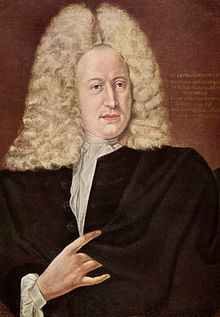Johann Georg Liebknecht

This article needs additional citations for verification. (January 2020) |
Johann Georg Liebknecht (23 April 1679 in
Biography
He was born the son of Michael Liebknecht, schoolmaster, of Wasungen, and his wife, Margarethe Turckin and was educated in the Gymnasium at Schleusingen and at Jena. He was awarded MA (1702), BD (1717) and DD (1719) [1]
Liebknecht was offered a position, on the recommendation of Gottfried Wilhelm Leibniz, at the small state university in Giessen; he was versatile and could teach several subjects competently. He was both a respected evangelical theologian and a leading mathematician. Other focal points of his work lay in the application of mathematics in the military (artillery, fortresses), geology (mineral deposits), archeology (excavations of grave mounds near Giessen), fossils and astronomy. Like other Protestant theologians he avoided, even after 200 years after Copernicus, supporting the heliocentric world view. He was in contact with famous scientists such as Leibniz. From 1707 to 1737 he was Professor of Mathematics at Giessen and from 1721 until his death also Professor of Theology.
From 1715 he was a member of the
Sidus Ludoviciana
Liebknecht was a keen astronomer. He made some of the rare
Family
He married twice; firstly Catharine Elisabeth, daughter of Nikolaus Caspar Elwerten, physician, of Bensheim and secondly Regina Sophie, daughter of Johann Just Hoffmann, physician, of Isenburg. He had 21 children from his two marriages.
References
- ^ a b "Library and Archive Catalogue". Royal Society. Retrieved 2012-03-06.
